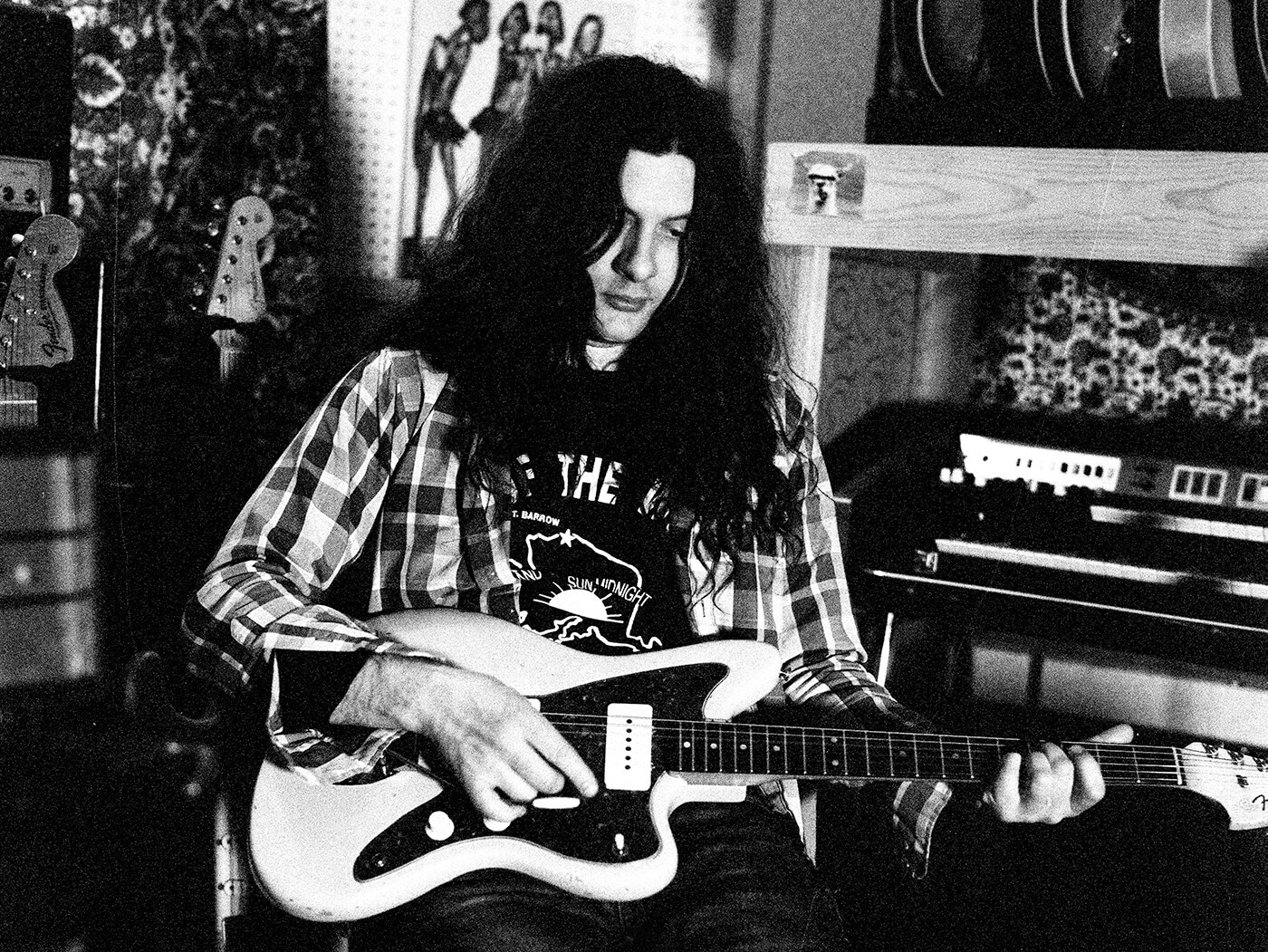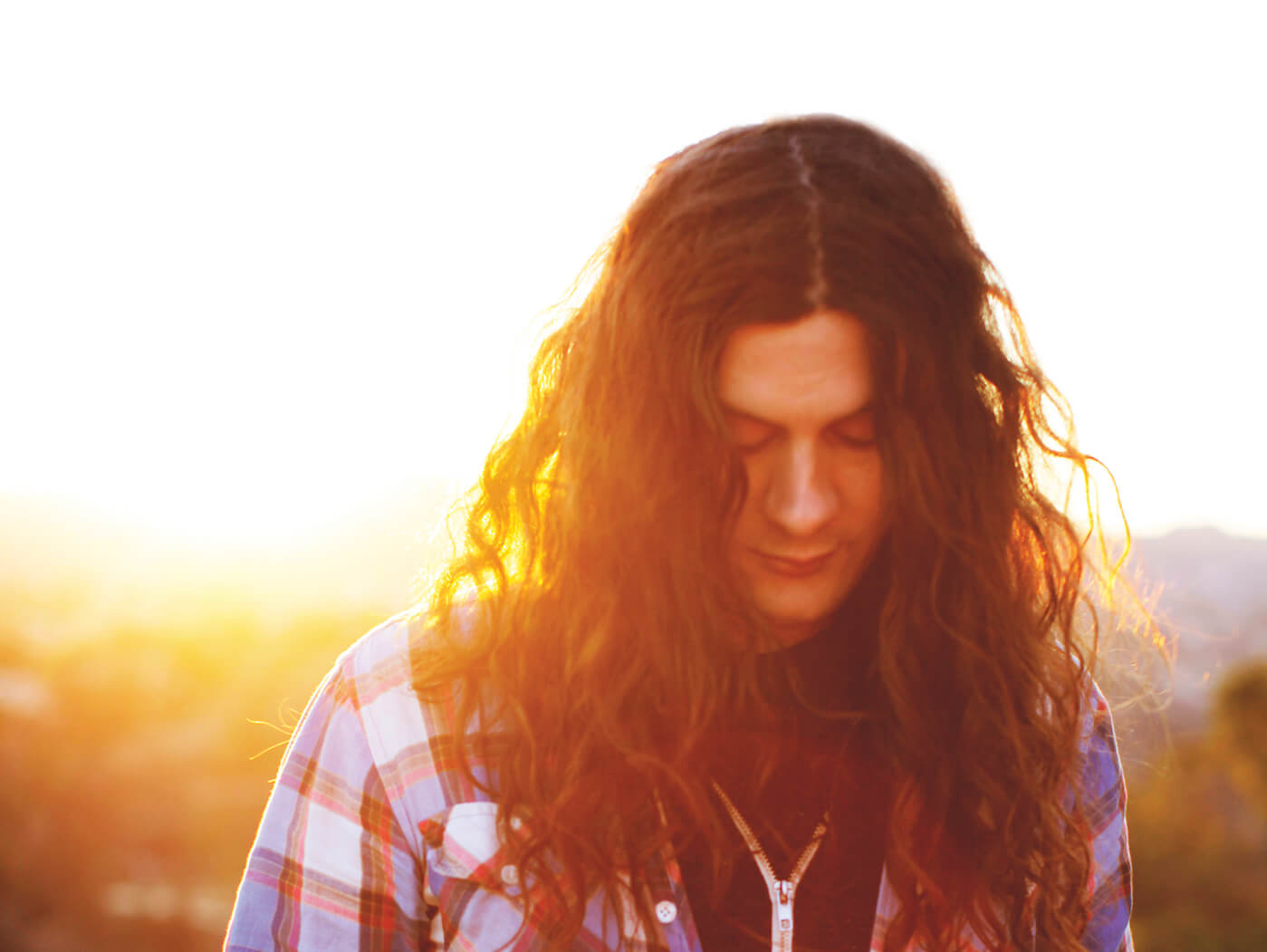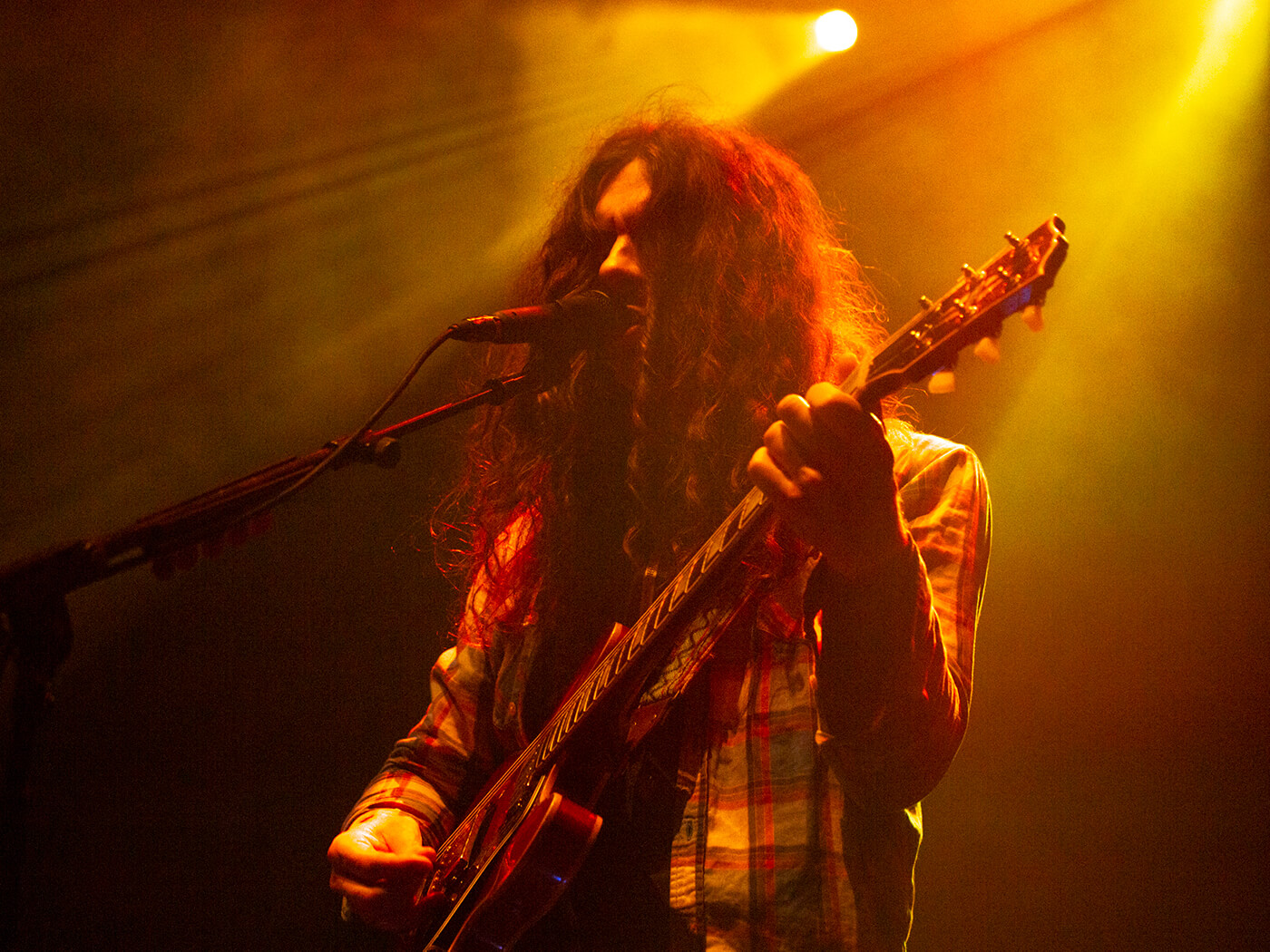Interview: Kurt Vile, indie rocker and slacker deity
Over the last five years, Kurt Vile has risen to the status of slacker-messiah to the US indie-rock scene: but he’s also a phenomenal guitar player, a pin-sharp songwriter, and a Jaguar evangelist.

Image: Jo McCaughey
There’s something a bit different about Kurt Vile. With his plaid shirt, skinny jeans and a grungey mop of hair that obscures large portions of his face, the gangly 38-year-old Philadelphian should blend seamlessly into the bar of this ultra-hip Shoreditch hotel. And he does… but at the same time, he stands out.
But then perhaps we shouldn’t be surprised at his ability to occupy two states at once – given that, over the last few years, Vile has managed the impressive feat of remaining an enigmatic outsider while still capturing the zeitgeist of contemporary alternative music.
He might not be topping the pop charts (though his signature tune, 2015’s Pretty Pimpin, was a sizeable US radio hit), but make no mistake, Kurt Vile is popular with the right people. Neil Young has taken him on tour, as have Thurston Moore and J Mascis; he’s played with John Cale and Cyndi Lauper, and released a critically acclaimed album, Lotta Sea Lice, with Courtney Barnett in 2017. He also straddles genres and generations – country megastar Keith Urban is a noted fan, as is Kiwi indie-pop sensation, Lorde. So if you’re yet to catch up with him, what’s all the fuss about?
In an era where image is everything and authenticity is a rare commodity, there’s something attractively real about Kurt Vile’s music. His songs are always personal yet intentionally vague, while musically, he cherry-picks from whatever has inspired him in that moment – from folk and country to grunge and hip-hop – and smashes it all together to create songs that sound both timeless and fresh, when both qualities are in short supply.
Droning on

Perhaps part of the reason Vile’s music sounds so refreshing is his approach to the guitar, which was borne out of another instrument entirely.
“I always wanted a guitar most of all, but my dad got me a banjo when I was 14, and I used to play it like a guitar,” Vile explains of his first steps into the guitar world. “My parents actually were going to get me a guitar for Christmas the year before, but I was really bad [laughs], so they ended up getting me a banjo for the next birthday! And then later, my neighbour would always hear me playing that banjo on our front porch, and they actually gave me an acoustic guitar.”
Trying to play guitar on a banjo isn’t the most conventional way to learn the instrument, but on reflection, Kurt can see the impact it had on the development of his droning, fingerpicked six-string style.
“It definitely informed it a little subliminally, for sure,” he agrees. “Because banjos are in an open tuning, and they’ve got that high drone string. It’s not like you’d even think about that when you’re playing as a kid, but I came to really like that ethereal drone.
“You end up dissecting these things later in life, and then you realise! I took some basic banjo lessons when I was a kid, and he taught me just the chords to songs, but still, the fact that it was all in open G… both literally, and figuratively in your mind, it makes things more open. Whereas if I’d taken guitar lessons where they teach you barre chords and all that… it puts you in a box, you’d have bars around you, barre chords!”
Independent spirit
Kurt began writing songs almost as soon as he picked up that banjo – inspired in part by the serendipitous emergence of “weird” alternative rock in the 90s, such as Beck, Pavement and Ween at that time – and before long, he was picking up electric guitars and searching for interesting gear and interesting sounds.
“You don’t really know anything about gear in your teens, but I think when I was about 17 or 18, I got a Les Paul, but it was called The Paul,” Vile recalls. “It was like, walnut? I still have it, in fact, and I used it on my early recordings. If you listen to my The Hunchback EP, that was the quintessential The Paul sound! It’s The Paul going through one of those very awesome purple Line 6 filter pedals [the FM4 Filter Modeler – Ed] through a Fender Champ. That was a very cool sound!”
Around this time, Kurt started recording his music, and his early experiences instilled a DIY ethos that still fuels him today.
“That’s been there from the start,” he affirms. “I had a friend, and his older brothers recorded me because they were recording his band, so right away, without knowing, the home-recording DIY thing was always around for me. I would record myself on a shitty tape recorder, and then CD-Rs came along and I was putting out CD-Rs! It wasn’t until I was 28 years old that somebody finally put something out of mine for real, but I was putting out plenty of my own CD-Rs until then!”
Having such a long period paying his dues definitely gives Kurt an appreciation of where he is today, now signed to international indie label Matador.
“Yeah, I feel lucky, because from 17 to 27, that’s 10 years when it was just this homespun thing,” he reflects. “Then from 28 to now at 38, that’s another 10 years – and that’s been the era of labels actually putting me out. But I’m still doing things my own way.”
Grand designs

In the early 2000s, Vile left his native Philadelphia and moved to Boston, where he worked as a forklift driver while spending his downtime making music and experimenting with his sound. “I had an eight-track and I had a job, so I could buy all these pedals and all these synths,” he explains. “I was getting pretty psychedelic there… so I had to do something and make some new friends!”
His solution was to head back home, where his paths crossed with another hotshot guitar player, Adam Granduciel – better known as the bandleader of The War On Drugs – and the two really hit it off.
“I met Adam in 2003 and we started playing together until about 2005, but just casually,” Kurt recalls. “But then 2005 to 2007 was a real renaissance, and we really connected. He recorded on a tonne of my stuff, my Kurt Vile & The Violators stuff, and I’d been playing in The War On Drugs casually, but then that became more serious, too.”
It ended up with the curious situation that both were effectively filling the role of lead guitarist in the other’s band, but despite their partnership yielding mutually beneficial results, the two friends remained fully committed to being the captains of their respective ships first and foremost, and they even became a little competitive with it…
“I was always happy to be involved with him, but then once he got a record deal with Secretly Canadian… ’cause I’m an ambitious person, I was mentally out of the band. I was like: ‘Hey, fuck this!’” Vile laughs.
Despite his obvious desire to do his own thing, however, Vile instantly dismisses the notion that the pair went their separate ways anything other than amicably.
“I still went on tour with The War On Drugs and I was lucky enough to have him come and play on my first Matador record, which I started recording before The War On Drugs, but it came out after,” he explains. “And then with Smoke Ring For My Halo [Vile’s breakout 2011 LP], I was lucky to have him continue to play in The Violators [Kurt’s backing band] – he actually played longer with us than I did with him! And I really love his Slave Ambient record. I guested on that, but that’s when he became really busy with The War On Drugs. He hasn’t played in The Violators since – and now he’s definitely too busy!”
Pimpin’ ain’t easy

In 2015, Vile released his sixth studio album, B’lieve I’m Goin Down, and with it came his first real taste of mainstream crossover. “In a way, that was me trying to get back to my roots, in that I didn’t have a producer in the beginning,” he reflects. “But it had Pretty Pimpin, which I guess became my biggest radio hit.”
If there’s one song that has cemented Vile’s place in the indie-rock mainstream, it’s that one – four minutes and 59 seconds of hypnotically looping, relentlessly catchy fingerpicked guitar, paired with sublimely odd stream-of-consciousness lyrics. It topped the Billboard Adult Alternative Songs charts in 2016.
“I knew it was a catchy riff, the fingerpicking riff,” Vile reflects of how that song came together. “But I had the right people playing with me – Stella Mozgawa from Warpaint on drums was unreal. The band was heavily involved in that record for sure. There was a lot of times where it was just me and my bandmate Rob Laakso, we put our heads together, and here we are.”
Hitting the bottle
Since B’lieve I’m Goin Down, Vile has enjoyed further chart success with Lotta Sea Lice, his album with Courtney Barnett, but now he’s back with his first proper solo effort since, Bottle It In. It’s Vile’s most diverse and interesting album to date, no doubt impacted by
the album’s long gestation – its recording was fitted in and around his varied other projects.
“It was a long process,” he affirms. “But in another sense, the recording was pretty fast. Because I’d record here and then go and do something else, then go and record somewhere else and do something else. I have a whole album’s worth of material that didn’t even make the record. It’s just my way of life – recording when I can and then figuring out what the record is going to be later.”
It’s also an album jam-packed with freewheeling and interesting guitar work, born of an improvisational approach to recording.
“I try to sing and play live, or at least have an instrument there in case I feel the need to play, and in the song Skinny Mini I did not know I was going to rip a couple of insane solos!” he chuckles. “It was so loud! We borrowed this 1950s Bassman. The guy we borrowed it from was like: ‘Be careful, those are the original speakers!’ – and we just cranked it! I had this song with these lyrics, but I didn’t know it was going to be so long, and I didn’t know I was going to crank this solo in the middle of it… and then I certainly didn’t know I was going to come back and do it again! But the tremolo bar thing just felt good.”
Indeed, when he reflects on his favourite guitar moments on Bottle It In, it seems like the ones that took him by surprise came out best.
“I like a lot of the solos in Hysteria – I didn’t know I’d be ripping solos in that, either!” he laughs. “I never know – it’s not planned! The guitar synth in Loading Zones… I didn’t know that was going to happen, either! I just knew I wanted to try it, so I tried it on that.”
Big cats

Electrics-wise, Kurt’s weapon of choice has long been a vintage Fender Jaguar – an instrument he’s so associated with, he was asked to be the face of Fender’s American Original Jaguar campaign, when it was launched earlier this year.
“I like Fender Jaguars and I like filter pedals,” he succinctly sums up. “It takes a while to make ’em work! I use a Mastery bridge on them, and I try to get the pre-CBS ones, because they’re made really well – but I’ve had lots of others that are, too. They look cool. That’s really important! There’s this band that my bandmate Rob grew up listening to, and ended up being in, called Swirlies. They were like an American My Bloody Valentine, but more raw and with cool synths. They used the Jaguar in a way that was close to My Bloody Valentine, but it was a little more American – a bit more garage-y, more raw. And it kinda comes from that, y’know?
“I prefer vintage gear, but I do like some of the new stuff that’s coming out. Fender has promised me some guitars! They’re going to make me a custom Jag, and they’re supposed to give me one of the George Harrison Rosewood [Telecasters]… both were promised to me, but I guess I should get back in touch and see what’s up!” When it comes to amplifiers and effects, Kurt is leaning towards the smaller and more minimal end of the scale.
“Towards the end of the record, Fender sent me one of those ’57 Champ reissues, and that was really cool,” he recalls. “I love the fact that it’s so small and you can just turn it up – and I’ve since bought an actual 1950s version. I borrowed my bandmate Jesse’s Moog MIDI MuRF and used it on that song, Yeah Bones. I like Minifoogers – I use a bunch of those. I love filters of various kinds…”
Giving it air

While he loves his electric, Vile is also a fabulous acoustic player, who leans on a pair of lesser-seen Martin Philadelphia Folk Festival models for the bulk of his acoustic work. “They sound absolutely amazing, they sound old, but they’re pretty new,” he enthuses.
“I have a couple of Baxendale acoustic guitars. That company, they refurbish old Harmonys and Kayes and make them more solid. I also really like those old Fender Palomino acoustic guitars – they’re kinda cheap, but kinda awesome! I’ve got so many acoustics, I’ve got this black Waterloo acoustic… that thing is amazing. I played it on Bassackwards. Part of me wants to take them on the road, but whenever I take a really good acoustic on the road, it never sounds the same afterwards.
“I’m not too precious about gear, plus I like the way guitars look when they’re beat up, but there’s certain ones that I just have to draw the line with.”
As such an accomplished player on either electric or acoustic, we round off our chat by asking which he prefers, and he pauses to consider for a moment. “I’m both, but if I had to pick one, I would say acoustic,” he finally answers. “Because that’s where I can just sit down on my couch and write a tune. What’s better than picking something up and playing it without having to plug it in or anything?
“And electrics don’t always have to be electrified, either. Sometimes with an electric guitar, I’ll buy it and it feels so good that it’ll be weeks before I even plug it in. I just love the way it sounds acoustically so much, sometimes it’s almost startling to plug it in. Like: ‘Oh fuck, it sounds weird! It sounded so good unplugged!’”
Kurt Vile’s latest LP, Bottle It In, is out now on Matador Records.
